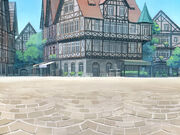The City of Cuan, also known as Lodan Lir's Pearl, is one of the most important cities in the Free Lands, where the Mór-River and the Coill-River meet to form the Imeall-River. A crossroads of rivers, trade and commerce, an economic center for small industry and services, the city grew over the last few years.
With the Grand Temple of Lodan Lir and the main garrison of the Arrowmaidens, the City is also a religious center.
In 2022, 10,664 people lived in the City and another 28,331 people in the Hinterlands (38,995 in total). Mayor of the City is Finnegan Méara of the Tribe of Louth.
History
- ca. 5750 BCE: First evidences of settlement in the area. Permanent settlement by 3,500 BCE.
- 1299/1300: Under Siege during the Crusade - see: Siege of Cuan (1299-1300). The victory of the Selkie in this battle proved to be the turning point. This was also the first larger battle commanded by Gwen Lách of the Tribe of Galway.
- During the Yard Crisis, Cuan was hit especially hard, the river-yards struggling hard and the youth rebelling. This came to a head in 1975, when the 5th Regiment of Uhlans, today's 5th Dragan-Regiment, was called to bring Cuan back under control and to squash the protests of the youth. The detachment of the I. Squadron was led by a young officer named Finn Nióchan of the Tribe of Cork, who took position on the Búistéir Street, the protesters on one side, he and his men on the other. He refused the direct order to have fire opened and saved countless lives, risking his own - and received 200 leashes as a punishment for disobedience.
- 2019 Cuan Spring Festival.
- 2022 Cuan Spring Festival.
Geography
Cuan is in a very nice position, roundabout at the midway point between Lake Mór and the ocean and at the point, where the Mór-River and the Coill-River meet to form the Imeall-River.
To the North, the Féar Plain stretches out,
Internal Geography
The City Center is the Láir Square, bordered by the Grand Temple of Lodan Lir, the City Hall and the Main Garrison of the City Guard.
The entire Old Town is surrounded by the City Wall, the River-Harbours sitting on the outside to the south and the east. The Scodalaigh-Quarter is in the middle between the river-harbours, outside of the City Walls. Several bridges span the rivers,
To the north, beyond the City Wall, but before the fortification works, there are several city quarters as well, the Tharballa-Quarter being among them.
To the south-west, along the banks of the Imeall, the Trasnú-Quarter has been built.
Demographics
- See also: Citizens of Cuan.
According to the 2018 Census, 6,374 people lived in Cuan and 15,337 in the City's Hinterlands. By 2022, that has increased to 10,664 and 28,331 people (38,995 in total), a near-doubling of the population, which sparked a massive boom in building of both traditional architecture and, along the western bank of the Imeall, of the Trasnú-Quarter, which was built between 2019 and 2026. Outside the City Wall to the north, the Tharballa-Quarter was built between 2018 and 2020 in a more traditionalistic style. The third city quarter is the Stilted Quarter.
In 1300, around 4,500 people lived in Cuan at the time of the siege.
Government
Mayor of the City is Finnegan Méara of the Tribe of Louth. He presides over the City Council and is democratically elected. He ascribes himself to the Reform-Movement.
Major issues of the city are its rapid growth, and the shortage of housing coming with it, public transport and public transport density, mechanization of private transport, as well as the Rivers and floodings by them. Current projections also see future problems in education, health and employment. Current building programmes, especially in regards to an expansion of the Cuan General Hospital, are in the planning stages.
SDF-Army Garrison
The SDF-Army has a small garrison, of the I. Squadron, 5th Dragan-Regiment, in the Patuna Barracks in Cuan.
Pedestrian Zones
The Old City is one giant pedestrian zone, signified by the city walls.
Economy
One of the major employers of Cuan is Bád Industries, which belongs to Silverport Dockyards Limited. The River-Yards in Cuan produce many of the smaller vessels sold by SDY, including, but not limited to, the Pattern 906 Cargo Lighters, the Inneall Dóiteáin-class Fireboats, Pattern 502 Landing Crafts, Kronprinzessin Irene von Wittelsbach-class Riverine Gunboats, Bevington-class Gunboats and a number of Fast Attack Craft. Bád Industries is also involved in the development of yachts and similar vessels, building them in the yards in Beál.
Gabha Motorworks Limited has a small factory in town as well. There, motorcycles are assembled.
Agriculturally, the areas north of the City in the Féar Plain is famous for its wheat and barley. Cuan's outlying communities are famous for their many small destilleries, which use these grains to produce grain and malted whiskeys. The towns and communities along the Mór are also known for their apple orchards and their pig husbandry, both for food and for leather, which is worked either in local workshops or, increasingly over the last years, in the clothes workshop of Bicíní Industries in Cuan itself (which was opened in 2020).
Thanks to its position at a major river crossroads, Cuan was always a major crossing point, its bridges (and bridge tolls) being an important source of income, as well as the fees of loading or unloading transports.
Infrastructure
Cuan is an important crossroads: The Mór-River, from Lake Mór, and the Coill-River, from the Cloch Mountains, meet here to form the Imeall-River, which flows down to the ocean. Two large river harbours serve the city as exchange points of wares and people, both being connected to the railway and to the Feadhain Roads.
A regional airport, which serves both floatplanes as well as wheeled planes, is a bit north of the City.
The Dolatúr Hydroelectric Power Plant a bit upstream is one of the main power suppliers in the region.
Inns
- See Main Article: Cluanaire Inn (Cuan).
There are several inns in Cuan, which are of high renown, for any and all price-classes, wishes and pockets. Some of the most famous are:
- The Ropaire Inn is one of the inns with the highest reputation and

The Ceol Inn, with the Ceol-Square behind the viewer.
- The Ceol Inn, one of the oldest inns in Cuan, is an old and venerable house – very good food, very good beds, nice staff and a spot in the city centre, at the Ceol Square. That comes at a high price.
- The Striapach Inn, one of the most wretched hives of scum and villainy in the Mór-Land, catering to the less reputable, but still decent and legal audience in the City. It is cheap, but don't expect anything too lavish. To many kinds of foreigners, the staff will be professional, but not breaking a leg with friendliness, more likely being a bit gruff. The food's good, though. The Striapach offers ' Additional Services'.
- The Laoch Inn, one of the regular haunts of the local SDF-Garrison, is a good and decent house, with a good band and good brews, as well as good food. The beds aren't too comfortable, though.
- The Ceannaí Inn is the inn, that might as well be a museum, as inn remembers the time of Cuan, where it was not a hub and junction of trade on the Mainland, but the hub and junction on the Mainland. It regularly housed more wealthy merchants on their stays in the City, which shows much in the building itself, lavishly decorated and with only the finest and softest of beds. It is very expensive and has a good, professional staff with exceptional food.
- The Sruth Inn is a small inn down by the river's harbour, usually used by the rivermen, when they need some rest after long days. Decent food, but very good beds, it caters also to the more active tourists, who eat outside.
- The Longchlós Inn is an inn by the facilities of Bád Industries, regular haunt of their workers and more frequent guests. Overall good, it offers its services at decent prices. It is the newest amongst the inns in Cuan with state of the art facilities and is still build of timber.
Education

Several students of the Póraitheoir High School, in School Uniforms. To the far right, Celina Treoraí of the Tribe of Louth, in the middle, Fiona Eas of the Tribe of Monaghan.
Cuan has two High Schools, one of them being the Póraitheoir High School, the other being the Mórlerá High School.
The Old University
Cuan, in times long since past, had its own little university, which was closed in 1900 due to a lack of students. The buildings are now known as the Old University, it's campus now used for a variety of purposes. Since 1925, the Cult of Lodan Lir uses parts of the campus as the Cuan First Seminary.
Culture
Cuan Cuisine
Music and Bands
Marcach
Cuan is famous for its archers and crossbowmen, including those of the mounted variety and the Arrowmaidens.
Cuan has three important trophies, which are regularly fought for: The Cuan City Trophy, the Cuan City Youth Trophy, both of which are horsearchery trophies, and the Ionsaí Trophy, a fencing trophy. All three are fought for every two years. The River's Crossing Trophy is fought for along the Mór-River and the tournament is held in Cuan once every blue moon.
Among Cuan's most famous Marcach currently in the league are the horsearchers Siana Crithan of the Tribe of Galway and Ciaran Brison of the Tribe of Laois. One of the most famous swordfighters from the city is, currently, Liv Gerartóir of the Tribe of Laois.
Arts
Temples and Sacred Groves
Grand Temple of Lodan Lir
Sacred Grove of the Swan
The Sacred Grove of the Swan is a small Sacred Grove by the Imeall, surrounded by trees, a small altar.
When she was still living in Cuan, Kiah Tincéir of the Tribe of Louth was responsible for the sacred grove.
Cuan-Sanctuary of Cailb
The Cult of Cailb has one of its most important sanctuaries in Cuan.
During her time as an Arcane Priestess, Morgane Macánta of the Tribe of Cork tended to the Sanctuary. Nowadays, that job falls onto Mavie Urgharda of the Tribe of Fermanagh.